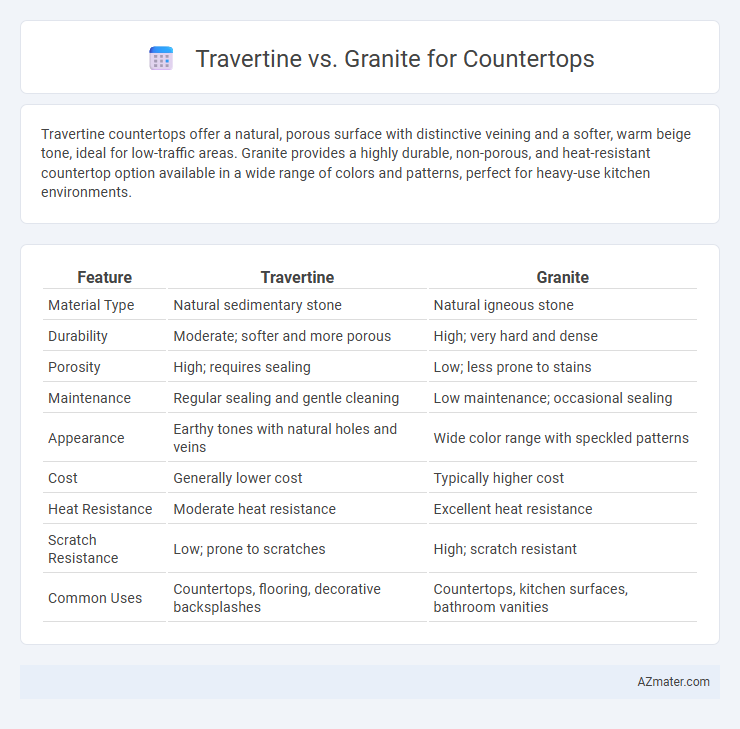Travertine countertops offer a natural, porous surface with distinctive veining and a softer, warm beige tone, ideal for low-traffic areas. Granite provides a highly durable, non-porous, and heat-resistant countertop option available in a wide range of colors and patterns, perfect for heavy-use kitchen environments.
Table of Comparison
| Feature | Travertine | Granite |
|---|---|---|
| Material Type | Natural sedimentary stone | Natural igneous stone |
| Durability | Moderate; softer and more porous | High; very hard and dense |
| Porosity | High; requires sealing | Low; less prone to stains |
| Maintenance | Regular sealing and gentle cleaning | Low maintenance; occasional sealing |
| Appearance | Earthy tones with natural holes and veins | Wide color range with speckled patterns |
| Cost | Generally lower cost | Typically higher cost |
| Heat Resistance | Moderate heat resistance | Excellent heat resistance |
| Scratch Resistance | Low; prone to scratches | High; scratch resistant |
| Common Uses | Countertops, flooring, decorative backsplashes | Countertops, kitchen surfaces, bathroom vanities |
Introduction to Travertine and Granite Countertops
Travertine countertops, formed from natural limestone with unique porous textures and warm beige tones, offer a luxurious and earthy appeal suited for various interior styles. Granite countertops, composed of highly durable crystalline structures, provide exceptional hardness, heat resistance, and a wide spectrum of color variations, making them ideal for high-traffic kitchen environments. Both materials require proper sealing to maintain their natural beauty and resistance to stains, ensuring longevity in countertop applications.
Appearance: Comparing the Aesthetics
Travertine countertops showcase a natural, porous texture with earth-toned hues such as beige, cream, and rust, creating a warm, rustic appearance ideal for Mediterranean or traditional styles. Granite offers a polished, glossy finish with a wide array of color variations including blacks, greens, pinks, and blues, providing a sleek and sophisticated look suitable for contemporary kitchens. The choice between travertine's matte, veined patterns and granite's bold, crystalline flecks directly impacts the overall kitchen ambiance and design coherence.
Durability and Strength Differences
Granite countertops exhibit superior durability and strength due to their dense, igneous composition, making them highly resistant to scratches, heat, and impact. Travertine, a softer sedimentary limestone, is more porous and prone to chipping, staining, and wear over time, necessitating regular sealing for protection. The inherent hardness of granite renders it the preferred choice for heavy-use kitchen countertops, while travertine suits lighter applications with careful maintenance.
Maintenance and Care Requirements
Travertine countertops require frequent sealing to prevent staining and etching due to their porous nature, making maintenance more demanding compared to granite. Granite is highly durable and resistant to scratches and heat, needing only periodic sealing to maintain its appearance. Regular cleaning with pH-neutral products is essential for both materials to preserve their finish and longevity.
Cost Comparison: Travertine vs Granite
Travertine countertops typically cost between $15 to $30 per square foot, making them more affordable than granite, which ranges from $40 to $100 per square foot depending on quality and source. Installation expenses for travertine are generally lower due to its softer nature, while granite requires more specialized tools and labor, increasing overall costs. Maintenance costs for travertine can also be higher since it is more porous and prone to staining compared to the durable and low-maintenance granite countertop surfaces.
Heat and Scratch Resistance
Travertine countertops offer moderate heat resistance but are more prone to scratching due to their porous and softer surface, which requires regular sealing to maintain durability. Granite provides superior heat resistance and exceptional scratch resistance thanks to its dense, hard composition, making it an ideal choice for high-traffic kitchen areas. Homeowners seeking long-lasting countertop materials often prefer granite for its ability to withstand hot pots and sharp utensils without damage.
Installation Process and Considerations
Travertine countertops require meticulous sealing and professional installation due to their porous nature, making them vulnerable to staining and moisture penetration. Granite, being denser and more durable, allows for easier cutting and fitting but demands precise measurement for proper edge finishing and support due to its heavier weight. Both materials need skilled labor to handle seams and prevent cracking, but granite generally offers more straightforward installation with longer-lasting resilience.
Environmental Impact and Sustainability
Travertine countertops have a lower environmental impact due to their abundant natural availability and less energy-intensive quarrying process compared to granite. Granite extraction requires more energy and generates higher carbon emissions because of deeper mining and extensive processing. Choosing travertine supports sustainability by reducing carbon footprint and promoting the use of a more eco-friendly natural stone option for countertops.
Suitability for Kitchen and Bathroom Settings
Travertine countertops offer a natural, porous surface that adds warmth and elegance to kitchens and bathrooms, but require regular sealing to prevent staining and damage from moisture. Granite is highly durable, resistant to scratches, heat, and stains, making it ideal for high-traffic kitchen environments and moisture-prone bathroom areas. Both materials suit their respective spaces, but granite's low maintenance and superior resilience make it a more practical choice for busy kitchens, while travertine adds aesthetic appeal in lower-usage bathroom settings.
Pros and Cons: Travertine vs Granite Countertops
Travertine countertops offer a distinctive, natural appearance with warm earth tones and unique porous textures ideal for rustic or Mediterranean designs, but they require frequent sealing due to their susceptibility to staining and etching. Granite countertops are highly durable and resistant to scratches, heat, and stains, making them a low-maintenance, long-lasting option with a wide range of color variations, although they tend to be more expensive and heavier to install. Choosing between travertine and granite depends on balancing aesthetic preferences with practical concerns such as durability and maintenance requirements.

Infographic: Travertine vs Granite for Countertop
 azmater.com
azmater.com